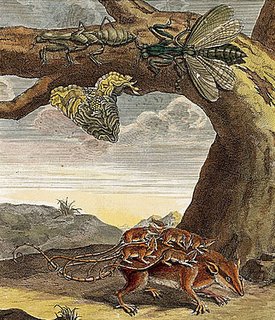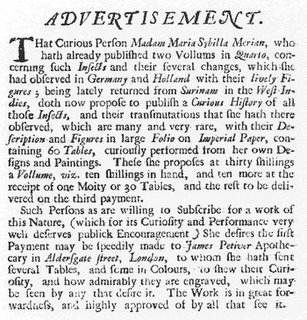

Maria Sibylla Merian (1647-1717) was three years old when her engraver father died. On his deathbed legend states that he predicted that the family name would become famous through his daughter. She developed an interest in the natural world and in insects in particular and she collected specimens for study from a young age. Her mother married a Flemish artist who encouraged Maria with her artistic talents and she began to paint scenes showing the life-cycles of butterflies by preference, in an age when it was widely believed that insects formed naturally from dirt. They moved from Germany to Holland where Maria spent much of the remainder of her life.


Maria found favour with some of the city leaders of Amsterdam after publishing two books of her paintings. She had come there with her daughters from a religious colony after a couple of failed marriages. Through her eldest daughter's marriage to a merchant, she began to be attracted to the South American Dutch colony of Surinam. After eight years planning, she and her youngest daughter went on their own to Surinam, their passage paid for by the city of Amsterdam. She spent two years there continuing with her study and painting of insects.
She released the first volume of her most famous work Metamorphosis Insectorum Surinamensium in 1705 which became the third recording of the pupae-caterpillar-butterfly in print. Her scientific renderings although sometimes inaccurate, are still regarded as a great accomplishment and she attracted the notice and praise of Linneaus. There were a number of publications of this work, with a second volume released after her death. Maria had also painted, engraved and hand coloured a large number of botanical and insect depictions during her latter life teaching of embroidery and painting. So although there were supposedly 60 plates made originally from her time in Surinam, this number burgeoned with reprintings.
Maria died a pauper after having suffered a stroke a few years earlier and another legend has her receiving news of the Russian Tsar's agreement to purchase her papers and paintings on the day she died. In fact, all her works did end up in Russia so it is likely the agreement was reached earlier. They were later returned to Germany.

No comments:
Post a Comment